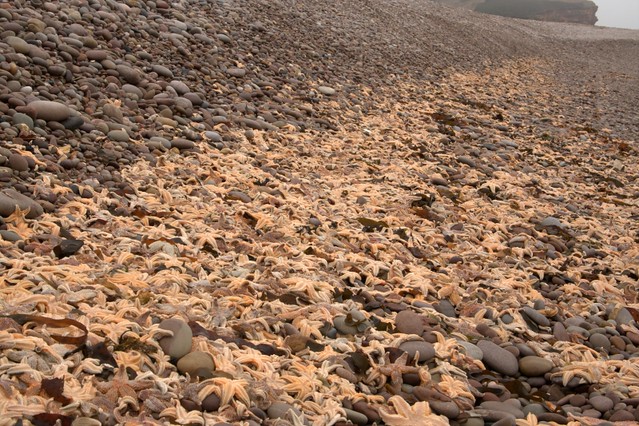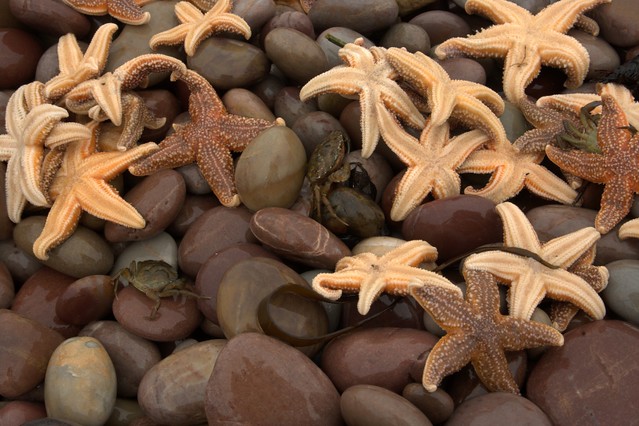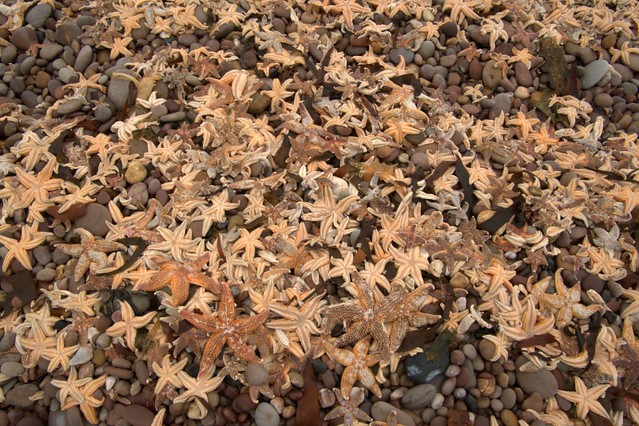 |
Asterias forbesi from South Carolina via http://wbtw.com/2015/02/10/1000s-of-starfish-wash-ashore-on-sc-island/
So, for whatever reason, I've been noticing an uptick in the number of reports (and questions from the public) about moribund or otherwise dead starfishes (aka sea stars) being washed up on beaches en masse.
|
And I've seen a host of different reports. Many from the southeast coast of the United States, in the United Kingdom and even from Cape Town, South Africa.
I thought I would take a moment to provide what seems to be the MOST likely explanation: During storms, violent or strong water currents pick starfish up off soft sediment bottoms and wash them ashore.
Different species of starfish in different parts of the world are affected but all share certain commonalities.
So here's the thing. As a scientist I've NOT actually seen storm-driven currents pick up hundreds to thousands of starfish and drop them on the beach. My conclusion is based on an assessment of various environmental factors which all point to, what seems to me, a parsimonious conclusion.
You'll often see a lot of officials and local biologists essentially say the same thing. There are LOTS of these starfish present AFTER a storm.
None of them actually saw what happened (and how could they have?) but this seems like an explanation which fits all the facts.
Lines of reasoning and evidence pointing to the "storms beach starfish" hypothesis
- In almost EVERY instance that this has been reported, there have been reports of either storms or high winds. Even if this was not necessarily reported in the news report itself. For example in the case of the Queensland Pentaceraster case, there was a reported storm involving hail the day before!(here)
- Bear in mind that storms don't JUST mean high winds and rough water current. It also means FRESH WATER input. Echinoderms are notoriously intolerant of low salinity/freshwater. Low salinity water might serve to weaken or otherwise just disable enough of them to be washed ashore.
- The species in question: Luidia clathrata, Pentaceraster sp., Asterias forbesi, Asterias rubens etc. (and others) are all known to occur on sandy or unconsolidated (i.e. loose sand) sediment bottoms. So its not unreasonable to see how strong water currents associated with inclement weather could serve to pick them up and drop them ashore. These species all tend to occur with rather high abundance so they tend to end up washed ashore in great numbers.
1. There are SO many dead! Will the starfish population recover?
Yes. Almost certainly. Although it seems like hundreds to thousands of individuals bear in mind that many of these species occur over a huge area (Luidia clathrata for example occurs throughout the Gulf of Mexico and along the southeastern coast of the United States) and their spawn includes hundreds of millions of individuals.
A related question to this usually involves "If they survive, shouldn't they be put back?" Unfortunately, its unlikely that most of them have survived by the time they've been found. Would it be good to have them returned to the ocean? Sure. And in fact, the good folks in Fish Hoek Beach in Cape Town, South Africa did just that!!
The living starfish (species: Marthasterias glacialis) were collected and returned to the ocean. From an ecological/population ecology perspective this was probably a trivial event but it says a lot about the people involved. So good on them!
2. Based on the news articles, scientists are always BAFFLED! BAFFLED I tells ya'! About this "starfish washing up thing" Why is that??
So, uh... scientists are not REALLY baffled by these events. Almost every article about starfish washing up on a beach usually involves a scientist providing an explanation for what happened. Usually involving a storm or freshwater input. But as I said before none of them (myself included) actually SAW what happened. And so their explanation is usually filled with qualifiers and caveats that the news media exploits as "SCIENTISTS BAFFLED BY THIS THING THAT HAPPENED!"
and of course, there is a.. how shall we say... "sensationalist" element which is used to make the story a bit more appealing to the general populace.
But really? It was probably storms stranding them on the beach.
3. OH NOES! We recently read about whales/dolphins/jellyfishes being stranded on the beach!! Does this mean the starfish are all dying and beaching themselves on the beach for the same reason???
*sigh* No. No it does not.
Animals such as whales, dolphins and jellies (jellyfish) all swim in the water column. In the case of animals like jellyfish and/or by the wind-sailors, water currents end up carrying a bunch of them onshore. Its not always clear what beaches whales and dolphins (or if there is a single reason in every case) but in these cases, we have animals that are in constant motion that get stranded based in part on the animals getting there on their own power.
Starfish live on the ocean bottom. They get picked up and carried to the beach. Its a localized event tied to something specific..like a storm. It would have to be VERY unusual to see some kind of event that would be the sole cause of mortality affecting constantly swimming (i.e., pelagic) animals like dolphins and bottom living invertebrates like sea stars.
4. OH NOES! ITS TEH STARFISH WASTING DISEASE!!
Nope. When starfish succumb to starfish wasting disease (aka starfish wasting syndrome, etc.) they show white lesions and in most cases they disintegrate in place, whether its underwater or in the intertidal or wherever. Image from the UCSC Starfish Wasting Disease Page.
Currently, Starfish Wasting seems to be primarily centered on the west coast of North America.
Most of the animals one observes washed up on the beach generally seem to have been in good health.
Is it possible that infected starfish could begin to appear? Sure. But individuals would need to show lesions or other indications of disease which we have yet to observe.
5. OH NOES! ITS TEH End of Days/R'Lyeh is rising and Cthulhu is chasing the starfish out of the sea!!
If Cthulhu's return caused a massive storm surge, with high velocity wind and water currents and huge storms causing freshwater input to local ecosystems thus resulting in a big low-salinity wave that washed a bunch of starfish onto shore? then... maybe. But otherwise. no.
But seriously.. do I continue to be interested in beachings? Sure. Many interesting potential questions. Are we seeing more of these beachings because of climate change-related storms? How seriously do these storms affect the populations of these species? and more importantly their prey? How regularly do they occur? But let's keep them to normal, localized phenomena and not crazy, "end of the world" death storm events shall we??







5 comments:
Well obviously Chris, its Fukushima!!!!
(ha ha!)
Good evening. I'm from PH and I've been looking for articles about the ability of an echinoderm to withstand dehydration when it is washed ashore, and have not found any that answer my question. May I ask, how long does a sea star last above water? Does it live upto a few minutes to hours, or even days (since starfish above water dehydrate after 5 days)? Thank you!
It depends on the species..some can tolerate some dessication for hours to days but others instantly begin to show stress the moment they are removed.
Thanks, Chris. I was just this moment listening to Dickens's David Copperfield musing whether washed up starfish want to be tossed back into the sea. I appreciate you shedding some light on the question.
I always toss back in the sea anything that's meant to live there and is showing signs of life... It may seem like a minute gesture in the grand scheme of things, but it makes a massive difference to each individual creature. I also hate to see them butchered alive by seagulls -although those are my friends, too, and I know they need their food. We sometimes argue over my interference when incoming tides wash up schools of baby fish that don't yet know any better than letting the currents take them. :D
Post a Comment